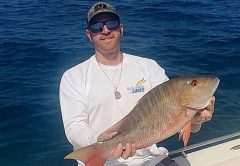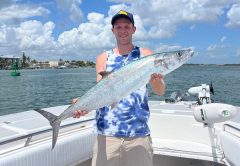
A couple of weeks ago I got a call from my good friend Jim Harter with an update on the tarpon situation up in the St. Lucie River. Jim is a fishing legend here in the Stuart area where he fishes the South and North Fork of the St. Lucie River more frequent than not. Long story short, Jim said that a lot of juvenile tarpon were seen rolling in the downtown Stuart area, but the water is really brown and muddy. I had a group of Germans fishing with me that week but decided to give it a shot.
When we arrived the following morning, we saw tarpon rolling all over the place and as Jim warned me the water was muddy as hell.
I decided to set up Achim and Mario with two different line sets and flies to cover different depths. One was going to fish an intermediate, Sink4 line with a rattle fly and the other one was going to fish a floating line with a big popper.
Achim cast his rattle fly on the sinking line a bit upstream into the fast moving current and whipped even more line out to make sure the fly could sink as deep as possible. I told him as soon as he feels the current pulling the line he should start stripping the line in with very short hard strips to make sure that the rattle works. It didn’t take long and a few casts later he got a good take from one of the tarpon, but he raised the rod and couldn’t hook this fish. Unfortunately he didn’t get another tarpon bite that morning.
A few minutes later Mario got lucky when a 20-pounder smoked his popper and after a short fight we landed that fish.
Using a variety of flies that are popping, pushing water and making noise in different depths can be a game changer even in the worst water conditions.
Always try different techniques even it’s out of your comfort zone and have fun!
PUBLISHER’S NOTE: Per FWC, anglers can temporarily possess a tarpon for photography, measurement of length and girth and scientific sampling, with the stipulation that tarpon more than 40 inches must remain in the water. To read more on recreational tarpon regulations, visit http://bit.ly/2meoBTn.
The Fly Fishing Column is written by Capt. Michael Mauri, www.mauriflyfishing.com, michael@mauriflyfishing.com, (772) 485-3321.




